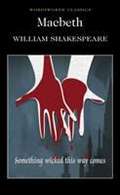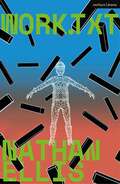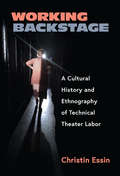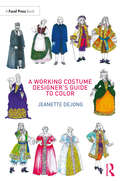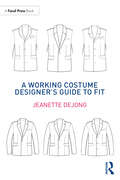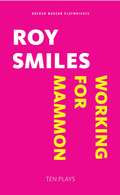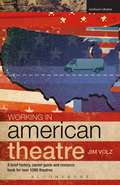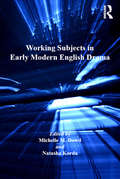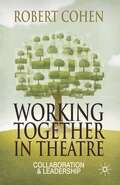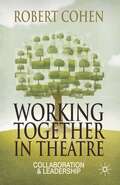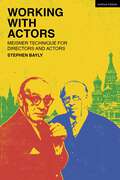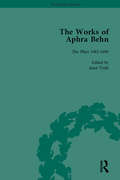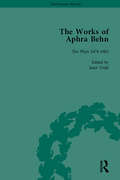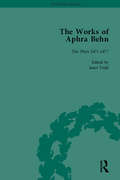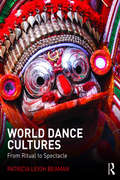- Table View
- List View
Wordsworth Classics: Macbeth (PDF)
by William Shakespeare Keith Carabine Cedric Watts Intro Notes ByEdited, introduced and annotated by Cedric Watts, Professor of English Literature, University of Sussex. Shakespeare's Macbeth is one of the greatest tragic dramas the world has known. Macbeth himself, a brave warrior, is fatally impelled by supernatural forces, by his proud wife, and by his own burgeoning ambition. As he embarks on his murderous course to gain and retain the crown of Scotland, we see the appalling emotional and psychological effects on both Lady Macbeth and himself. The cruel ironies of their destiny are conveyed in poetry of unsurpassed power. In the theatre, this tragedy remains perennially engrossing.
work.txt (Modern Plays)
by Nathan EllisHate your job? Come work for us.This is a show about work.But the worker isn't here, so it's down to you.You'll clock in at the beginning.You'll get short breaks at regular intervals.You'll work in a team, and under your own initiative.You will be your own boss.You will be free.work.txt is a show performed entirely by the audience about the gig economy, financial instability and bullshit jobs.This edition was published to coincide with the run at the Soho Theatre in London in February 2022.
work.txt (Modern Plays)
by Nathan EllisHate your job? Come work for us.This is a show about work.But the worker isn't here, so it's down to you.You'll clock in at the beginning.You'll get short breaks at regular intervals.You'll work in a team, and under your own initiative.You will be your own boss.You will be free.work.txt is a show performed entirely by the audience about the gig economy, financial instability and bullshit jobs.This edition was published to coincide with the run at the Soho Theatre in London in February 2022.
Working Backstage: A Cultural History and Ethnography of Technical Theater Labor
by Christin EssinWorking Backstage illuminates the work of New York City’s theater technicians, shining a light on the essential contributions of unionized stagehands, carpenters, electricians, sound engineers, properties artisans, wardrobe crews, makeup artists, and child guardians. Too-often dismissed or misunderstood as mere functionaries, these technicians are deeply engaged in creative problem-solving and perform collaborative, intricate choreographed work that parallels the performances of actors, singers, and dancers onstage. Although their contributions have fueled the Broadway machine, their contributions have been left out of most theater histories. Theater historian Christin Essin offers clear and evocative descriptions of this invaluable labor, based on her archival research and interviews with more than 100 backstage technicians, members of the New York locals of the International Alliance of Theatrical Stage Employees. A former theater technician herself, Essin provides readers with an insider’s view of the Broadway stage, from the suspended lighting bridge of electricians operating followspots for A Chorus Line; the automation deck where carpenters move the massive scenic towers for Newsies; the makeup process in the dressing room for The Lion King; the offstage wings of Matilda the Musical, where guardians guide child actors to entrances and exits. Working Backstage makes an significant contribution to theater studies and also to labor studies, exploring the politics of the unions that serve backstage professionals, protecting their rights and insuring safe working conditions. Illuminating the history of this typically hidden workforce, the book provides uncommon insights into the business of Broadway and its backstage working relationships among cast and crew members.
A Working Costume Designer's Guide to Color
by Jeanette deJongA Working Costume Designer's Guide to Color provides readers with the skills and knowledge to create coherent color schemes for costumes. Drawing on decades of experience in the costume shop, the author guides readers through every step of the process, from finding inspiration for a color scheme and successfully working with the design team to understanding how lighting design can affect costume color choices. Filled with step-by-step illustrations of how to add colors to a set of renderings and color-block samples to illustrate color theory, terminology, and usage of colors, the book covers a wide range of topics, including: How to add colors to a set of renderings to clarify characters and character relationships. How color interacts with surface pattern and fabric textures. Color theory and terminology. How to combine colors to make a coherent color scheme using different methods, including using dominant, supporting, and accent colors. How to flatter actors while staying within an overall color scheme. Color meanings in different cultures and for different time periods. How to manage costume changes to preserve or extend a color scheme. A valuable resource for students of costume design courses and professional costume designers, A Working Costume Designer's Guide to Color provides readers with the tools to create harmonious color schemes that will enhance the look of a production as whole.
A Working Costume Designer's Guide to Color
by Jeanette deJongA Working Costume Designer's Guide to Color provides readers with the skills and knowledge to create coherent color schemes for costumes. Drawing on decades of experience in the costume shop, the author guides readers through every step of the process, from finding inspiration for a color scheme and successfully working with the design team to understanding how lighting design can affect costume color choices. Filled with step-by-step illustrations of how to add colors to a set of renderings and color-block samples to illustrate color theory, terminology, and usage of colors, the book covers a wide range of topics, including: How to add colors to a set of renderings to clarify characters and character relationships. How color interacts with surface pattern and fabric textures. Color theory and terminology. How to combine colors to make a coherent color scheme using different methods, including using dominant, supporting, and accent colors. How to flatter actors while staying within an overall color scheme. Color meanings in different cultures and for different time periods. How to manage costume changes to preserve or extend a color scheme. A valuable resource for students of costume design courses and professional costume designers, A Working Costume Designer's Guide to Color provides readers with the tools to create harmonious color schemes that will enhance the look of a production as whole.
A Working Costume Designer’s Guide to Fit
by Jeanette deJongA Working Costume Designer’s Guide to Fit explores the concept of fit in theatrical costumes – what it is, how to assess it, and how to achieve it. Being able to assess whether a costume fits or not is a learned skill, which takes practice as well as information about what the fit standards are for different types of garments. Filled with detailed step-by-step illustrations, this book provides all the knowledge readers will need in order to achieve the perfect fit for their costumes, including: How costumes can support actors onstage when they fit correctly. How to take measurements and how to assess them. How to conduct a fitting and what materials are needed. How to resolve a number of issues that may arise during a fitting. How to fit a mockup test garment in preparation for building a costume from scratch. How to adjust a garment or mockup to fit better. Chapters 8-14 also explore different categories of garments and discuss how to check them against the wearer’s measurements before trying them on, what the standards of fit are for each category, and how to fit an existing garment. This is an essential guide for students of Costume Design courses and professional costume designers of any experience level.
A Working Costume Designer’s Guide to Fit
by Jeanette deJongA Working Costume Designer’s Guide to Fit explores the concept of fit in theatrical costumes – what it is, how to assess it, and how to achieve it. Being able to assess whether a costume fits or not is a learned skill, which takes practice as well as information about what the fit standards are for different types of garments. Filled with detailed step-by-step illustrations, this book provides all the knowledge readers will need in order to achieve the perfect fit for their costumes, including: How costumes can support actors onstage when they fit correctly. How to take measurements and how to assess them. How to conduct a fitting and what materials are needed. How to resolve a number of issues that may arise during a fitting. How to fit a mockup test garment in preparation for building a costume from scratch. How to adjust a garment or mockup to fit better. Chapters 8-14 also explore different categories of garments and discuss how to check them against the wearer’s measurements before trying them on, what the standards of fit are for each category, and how to fit an existing garment. This is an essential guide for students of Costume Design courses and professional costume designers of any experience level.
Working for Mammon (Oberon Modern Playwrights)
by Roy SmilesWorking for Mammon is a comedy drama about the London Riots of 2012 when the city seemed to go mad for a week and every shop with training shoes got looted. It concerns a teacher defeated by life who shelters a sixteen-year-old girl on the run from the police and a drug dealer who finds in her joy for life a new meaning to go on.
Working in American Theatre: A brief history, career guide and resource book for over 1000 theatres (Backstage)
by Jim Volz"I cannot think of a better book for aspiring and working actors, craftspeople, artists, and managers" Kent Thompson, Artistic Director, Denver Center Theatre Company, Past President TCG Board of Directors "It's time for a new look at the complexity and richness of America's growing theatrical landscapre and Jim Volz is just the person to provide that overview" Lesley Schisgall Currier, Managing Director, Marin Shakespeare Company Working in American Theatre is a coast-to-coast overview of the opportunities awaiting theatre practitioners in every discipline. Featuring tips from America's top theatre professionals, this resource offers job-search and career-planning strategies, as well as detailed information on over 1,000 places to work in the American theatre, including regional companies, Broadway and commerical theatre, Shakespeare festivals, touring theatres, university/resident theatres, youth and children's theatres, and outdoor theatres. Offering an overview of the evolution of American theatre and behind-the-scenes stories of the regional movement, this single volume is an indispensable tool at every stage of your career.
Working in American Theatre: A brief history, career guide and resource book for over 1000 theatres (Backstage Ser.)
by Jim Volz"I cannot think of a better book for aspiring and working actors, craftspeople, artists, and managers" Kent Thompson, Artistic Director, Denver Center Theatre Company, Past President TCG Board of Directors "It's time for a new look at the complexity and richness of America's growing theatrical landscapre and Jim Volz is just the person to provide that overview" Lesley Schisgall Currier, Managing Director, Marin Shakespeare Company Working in American Theatre is a coast-to-coast overview of the opportunities awaiting theatre practitioners in every discipline. Featuring tips from America's top theatre professionals, this resource offers job-search and career-planning strategies, as well as detailed information on over 1,000 places to work in the American theatre, including regional companies, Broadway and commerical theatre, Shakespeare festivals, touring theatres, university/resident theatres, youth and children's theatres, and outdoor theatres. Offering an overview of the evolution of American theatre and behind-the-scenes stories of the regional movement, this single volume is an indispensable tool at every stage of your career.
Working Subjects in Early Modern English Drama
by Natasha KordaWorking Subjects in Early Modern English Drama investigates the ways in which work became a subject of inquiry on the early modern stage and the processes by which the drama began to forge new connections between labor and subjectivity in the period. The essays assembled here address fascinating and hitherto unexplored questions raised by the subject of labor as it was taken up in the drama of the period: How were laboring bodies and the goods they produced, marketed and consumed represented onstage through speech, action, gesture, costumes and properties? How did plays participate in shaping the identities that situated laboring subjects within the social hierarchy? In what ways did the drama engage with contemporary discourses (social, political, economic, religious, etc.) that defined the cultural meanings of work? How did players and playwrights define their own status with respect to the shifting boundaries between high status/low status, legitimate/illegitimate, profitable/unprofitable, skilled/unskilled, formal/informal, male/female, free/bound, paid/unpaid forms of work? Merchants, usurers, clothworkers, cooks, confectioners, shopkeepers, shoemakers, sheepshearers, shipbuilders, sailors, perfumers, players, magicians, servants and slaves are among the many workers examined in this collection. Offering compelling new readings of both canonical and lesser-known plays in a broad range of genres (including history plays, comedies, tragedies, tragi-comedies, travel plays and civic pageants), this collection considers how early modern drama actively participated in a burgeoning, proto-capitalist economy by staging England's newly diverse workforce and exploring the subject of work itself.
Working Subjects in Early Modern English Drama
by Natasha KordaWorking Subjects in Early Modern English Drama investigates the ways in which work became a subject of inquiry on the early modern stage and the processes by which the drama began to forge new connections between labor and subjectivity in the period. The essays assembled here address fascinating and hitherto unexplored questions raised by the subject of labor as it was taken up in the drama of the period: How were laboring bodies and the goods they produced, marketed and consumed represented onstage through speech, action, gesture, costumes and properties? How did plays participate in shaping the identities that situated laboring subjects within the social hierarchy? In what ways did the drama engage with contemporary discourses (social, political, economic, religious, etc.) that defined the cultural meanings of work? How did players and playwrights define their own status with respect to the shifting boundaries between high status/low status, legitimate/illegitimate, profitable/unprofitable, skilled/unskilled, formal/informal, male/female, free/bound, paid/unpaid forms of work? Merchants, usurers, clothworkers, cooks, confectioners, shopkeepers, shoemakers, sheepshearers, shipbuilders, sailors, perfumers, players, magicians, servants and slaves are among the many workers examined in this collection. Offering compelling new readings of both canonical and lesser-known plays in a broad range of genres (including history plays, comedies, tragedies, tragi-comedies, travel plays and civic pageants), this collection considers how early modern drama actively participated in a burgeoning, proto-capitalist economy by staging England's newly diverse workforce and exploring the subject of work itself.
Working Together in Theatre: Collaboration and Leadership
by Robert CohenRobert Cohen draws on fifty years of acting, directing and teaching experience in order to illustrate how the world's great theatre artists combine collaboration with leadership at all levels, from a production's conception to its final performance. This book challenges the notion that creating brilliant theatrical productions requires tyrannical directors or temperamental designers. Viewing the theatrical production process from the perspectives of the producer, director, playwright, actor, designer, stage manager, dramaturg and crew person, Cohen provides the techniques, exercises and language that promote successful collaborative skills in the theatre. Collaboration is vital to successful theatre making and Working Together in Theatre is the first book to show how leadership and collaboration can be combined to make every theatrical production far greater than the sum of its many parts.
Working Together in Theatre: Collaboration and Leadership
by Robert CohenRobert Cohen draws on fifty years of acting, directing and teaching experience in order to illustrate how the world's great theatre artists combine collaboration with leadership at all levels, from a production's conception to its final performance. This book challenges the notion that creating brilliant theatrical productions requires tyrannical directors or temperamental designers. Viewing the theatrical production process from the perspectives of the producer, director, playwright, actor, designer, stage manager, dramaturg and crew person, Cohen provides the techniques, exercises and language that promote successful collaborative skills in the theatre.Collaboration is vital to successful theatre making and Working Together in Theatre is the first book to show how leadership and collaboration can be combined to make every theatrical production far greater than the sum of its many parts.
Working with Actors: Meisner Technique for Directors and Actors
by Stephen BaylyWorking with Actors provides the key to unlocking the honest, dynamic performance every actor has within them. It offers a well-articulated formulation of the Meisner Technique easy for directors and actors to use within a working context.Through setting out an accessible training programme for practitioners working across stage and screen, this book establishes a clear-cut route to building a three-dimensional character in an organic, non-intellectual fashion, based squarely on the character's objectives.Few books in this field venture out of the training studio, while in this book - alongside offering an intense and concentrated Meisner training programme - the focus is more on the 'pay-off': the collaborative act of developing the role and how that plays out in rehearsal and performance.Beyond that, the books uniquely offers:> a new modality for script reading, analysis and rehearsal through which the character is born in relation to other characters;> a prioritisation of the key skills for coming alive in the moment – listening and putting one's attention wholly on the other character/actor;> a historical perspective on how Meisner's methods have evolved and why they provide the basis of truthful acting;> for directors, a format for analysis of the complete work based on Stanislavskian principles;> for actors, complementary methods, such as Uta Hagen's 'endowment', to enhance the 'reality of doing'
Working with Actors: Meisner Technique for Directors and Actors
by Stephen BaylyWorking with Actors provides the key to unlocking the honest, dynamic performance every actor has within them. It offers a well-articulated formulation of the Meisner Technique easy for directors and actors to use within a working context.Through setting out an accessible training programme for practitioners working across stage and screen, this book establishes a clear-cut route to building a three-dimensional character in an organic, non-intellectual fashion, based squarely on the character's objectives.Few books in this field venture out of the training studio, while in this book - alongside offering an intense and concentrated Meisner training programme - the focus is more on the 'pay-off': the collaborative act of developing the role and how that plays out in rehearsal and performance.Beyond that, the books uniquely offers:> a new modality for script reading, analysis and rehearsal through which the character is born in relation to other characters;> a prioritisation of the key skills for coming alive in the moment – listening and putting one's attention wholly on the other character/actor;> a historical perspective on how Meisner's methods have evolved and why they provide the basis of truthful acting;> for directors, a format for analysis of the complete work based on Stanislavskian principles;> for actors, complementary methods, such as Uta Hagen's 'endowment', to enhance the 'reality of doing'
The Works of Aphra Behn: Poetry (The Pickering Masters)
by Janet ToddAphra Behn (1640-1689) was one of the most successful dramatists of the Restoration theatre and a popular poet. This is the final volume in a set of seven which comprises a complete edition of all her works.
The Works of Aphra Behn: Poetry (The Pickering Masters)
by Janet ToddAphra Behn (1640-1689) was one of the most successful dramatists of the Restoration theatre and a popular poet. This is the sixth volume in a set of seven which comprises a complete edition of all her works.
The Works of Aphra Behn: Poetry (The Pickering Masters)
by Janet ToddAphra Behn (1640-1689) was one of the most successful dramatists of the Restoration theatre and a popular poet. This is the fifth volume in a set of seven which comprises a complete edition of all her works.
The Works of Aphra Behn: v. 5: Complete Plays (The Pickering Masters)
by Janet ToddAphra Behn (1640-1689) was one of the most successful dramatists of the Restoration theatre and a popular poet. This is the fifth volume in a set of seven which comprises a complete edition of all her works.
The Works of Aphra Behn: v. 6: Complete Plays (The Pickering Masters)
by Janet ToddAphra Behn (1640-1689) was one of the most successful dramatists of the Restoration theatre and a popular poet. This is the sixth volume in a set of seven which comprises a complete edition of all her works.
The Works of Aphra Behn: v. 7: Complete Plays (The Pickering Masters)
by Janet ToddAphra Behn (1640-1689) was one of the most successful dramatists of the Restoration theatre and a popular poet. This is the final volume in a set of seven which comprises a complete edition of all her works.
World Dance Cultures: From Ritual to Spectacle
by Patricia Leigh BeamanFrom healing, fertility and religious rituals, through theatrical entertainment, to death ceremonies and ancestor worship, World Dance Cultures introduces an extraordinary variety of dance forms practiced around the world. This highly illustrated textbook draws on wide-ranging historical documentation and first-hand accounts, taking in India, Bali, Java, Cambodia, China, Japan, Hawai’i, New Zealand, Papua New Guinea, Africa, Turkey, Spain, Native America, South America, and the Caribbean. Each chapter covers a certain region’s distinctive dances, pinpoints key issues and trends from the form’s development to its modern iteration, and offers a wealth of study features including: Case Studies – zooming in on key details of a dance form’s cultural, historical, and religious contexts ‘Explorations’ – first-hand descriptions of dances, from scholars, anthropologists and practitioners ‘Think About’ – provocations to encourage critical analysis of dance forms and the ways in which they’re understood Discussion Questions – starting points for group work, classroom seminars or individual study Further Study Tips – listing essential books, essays and video material. Offering a comprehensive overview of each dance form covered with over 100 full color photos, World Dance Cultures is an essential introductory resource for students and instructors alike.
World Dance Cultures: From Ritual to Spectacle
by Patricia Leigh BeamanFrom healing, fertility and religious rituals, through theatrical entertainment, to death ceremonies and ancestor worship, World Dance Cultures introduces an extraordinary variety of dance forms practiced around the world. This highly illustrated textbook draws on wide-ranging historical documentation and first-hand accounts, taking in India, Bali, Java, Cambodia, China, Japan, Hawai’i, New Zealand, Papua New Guinea, Africa, Turkey, Spain, Native America, South America, and the Caribbean. Each chapter covers a certain region’s distinctive dances, pinpoints key issues and trends from the form’s development to its modern iteration, and offers a wealth of study features including: Case Studies – zooming in on key details of a dance form’s cultural, historical, and religious contexts ‘Explorations’ – first-hand descriptions of dances, from scholars, anthropologists and practitioners ‘Think About’ – provocations to encourage critical analysis of dance forms and the ways in which they’re understood Discussion Questions – starting points for group work, classroom seminars or individual study Further Study Tips – listing essential books, essays and video material. Offering a comprehensive overview of each dance form covered with over 100 full color photos, World Dance Cultures is an essential introductory resource for students and instructors alike.
